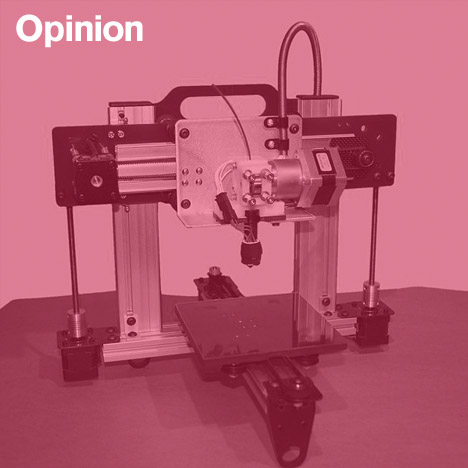
"We can't draft a new world and print it out"
Opinion: in this week's column, Sam Jacob argues that instead of liberating us, 3D printing will merely "bind us even more closely to fewer and fewer corporations".
If this is the year of anything, it’s the year of 3D-printing boosterism (even more than last year was). The overarching narrative surrounding 3D printing presents it as a liberating technology. It argues that the technology will free us from organised, centralised production of the industrial era. And it suggests that this radical break will in turn transform the political, economic and social structures that industrialisation precipitated.
There is a latent dream somewhere in this rhetoric, something like an electrified version of William Morris’ strange rural-futurist novel News From Nowhere. Morris’ protagonist goes to bed in the industrial 1890’s but mysteriously wakes into a post-revolutionary, proto-socialist nu-medievalist London.
It’s a London whose citizens craft themselves beautiful things in fulfilling equality. We imagine now, perhaps, our own sci-fi version of this utopia. A future where digital production technologies set us free. Where we are surrounded by sequentially layered self expression and customisation. Where we return, thanks to electronics and robotics, to an idealised folk-art state.
Yet of course, we’ve been on the cusp of techno-liberation before. Remember those wild, free years when the internet was young? Limitless fields of freedoms seemed to open up through the window of a squawking dialup modem. The information enclosures of Facebook, Google, Apple et al have long put paid to that sensation.
Let’s face it: 3D printing might give us a million new ways to make objects, but it is unlikely to undo our late capitalist relationship with objects. If the history of the internet is a lesson, then technology only accelerates us further towards the horizon of consumerism, deeper into the depths of digital modernity.
Think, for example, of the labour politics of 3D printing. There is something undeniably appealing (to designers) in the removal of the production process between the designer and their artifact, a shortening of the distance between their imagination and its physical product. But part of this appeal is that it shifts the value of the object toward the designer rather than the labour of production. It’s the total realisation of Ruskin’s critique of industrial capital’s division of labour, where ‘thought’ and ‘work’ are entirely estranged, where personality and invention are ringfenced by design rather than shared with production.
Inevitably it won’t be a democratic, distributed version of the technology that takes hold. It’ll be an iTuned, DRMified ecology that will bind us even more closely to fewer and fewer corporations. If we’re lucky enough to escape that fate, it will only be into the arms of a Pirate Bay of objects where we’ll find the 3D equivalents of screener films, dodgy 3D scans and partially ripped bootlegs.
Here’s another scenario, another possible version of a 3D-printed world. This one is a world that physically resembles the contents of your hard drive (if you are anything like me, that is). A world of half-completed files, a thousand drafts, weird duplicates, super high-res and hyper-compressed versions of the same file and lost aliases. A world made in the image of the detritus around the outlet of a photocopier. A world of copies with no originals. A world of undifferentiated, undetailed substance, endless landscapes of half-finished Sketchup models as though Google’s 3D warehouse had dumped itself back into the physical world. In other words, a super-proliferated Junkspace that would make even Junkspace blush.
Technology itself will not rescue us from our circumstance. We can’t draft a new world and print it out. In fact, the focus that digital design places on the object itself as an autonomous object, floating in its electronic amniotic sac, is itself a mirage of technology; a non-verbal argument about the nature of objects and society as much as a Fordist production line ever was.
If there is any hope of resurrecting Morris-esque resistance or Ruskinian ideology in a digital age, it is to recognise, as they did, that objects are not simply form but intrinsically politicised artifacts. And so are the technologies we use to produce them.
But 3D printing propels the idea of design-as-form to an extreme conclusion. It makes a persuasive argument for design as the production of autonomous techno-formalist objects. 3D printing might change how we make the world, but it won’t change the world itself.